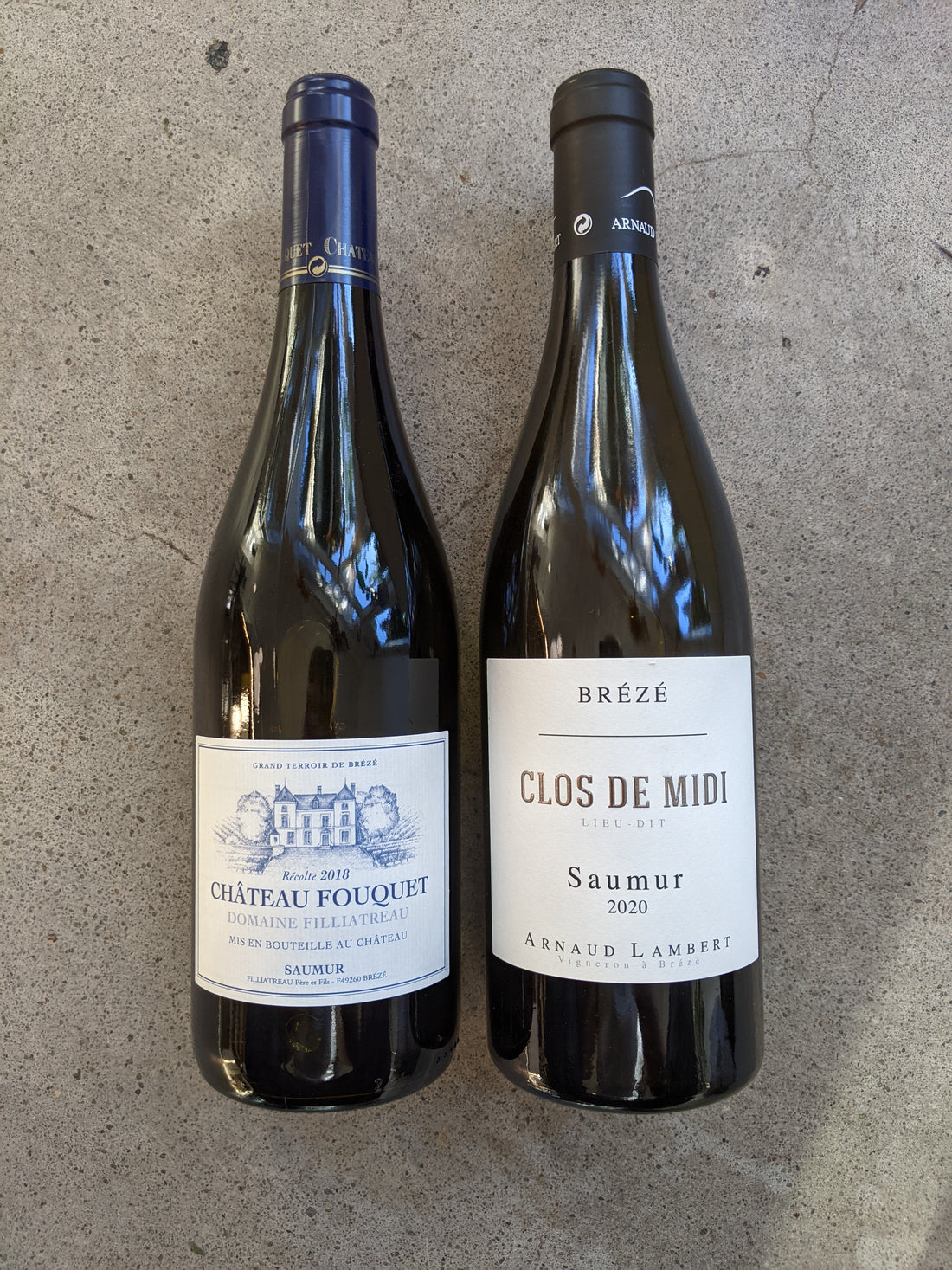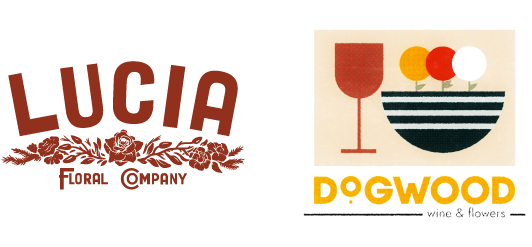
August 2021 - Brézé, Loire Valley, France
Wine Club - August 2021
Saumur / Brézé (Loire Valley)
Featuring:
Domaine Arnaud Lambert, ‘Clos de Midi’ Brézé, Saumur Blanc 2020
Domaine Filliatreau, ‘Château Fouquet’ Brézé, Saumur Rouge 2019
As the longest river in France, the Loire winds a staggering 1000 km from it’s headlands in the Massif Central to where it drains into the Atlantic Ocean, near the city of Nantes. Along this route one can find some of France’s most storied wine regions - Sancerre, Vouvray, Saumur-Champigny, Chinon, Savennières, Muscadet, and others. The land is verdant and lush, with picturesque castles lining the river and small towns providing tourists with plenty to see and do. The climate varies from intensely cool-climate maritime (Muscadet) to outright continental (Sancerre). The Loire Valley can be incredibly intimidating or challenging for students of wine as it has no one overarching style or theme. You can find wines of almost any color, style, or sweetness level here. And while four or five primary grapes dominate, one can probably find about 30 different varieties in regular production today.
The Loire Valley is also interesting in that, for the last 50 years, the Whites of this region have dominated most of the conversation. Historically, however, the reds were more revered and appreciated by French royals and laypeople alike. In fact, one to two hundred years ago, most of the white grapes growing in the Loire were destined for dessert wine production, especially Chenin Blanc. This is exemplified in the shifting perception of Sancerre. This region, which most people today think of as synonymous with Sauvignon Blanc, was largely planted to Pinot and Gamay until phylloxera hit. Since Sauvignon was easier to graft to American rootstocks (which are resistant to phylloxera), it became the primary variety to be replanted. Once this new style was introduced into the Parisian bistro scene after the reconstruction from WW2, the red-centric Sancerre of yesteryear was changed forever.
The reds of this region are mostly Cabernet Franc based once you leave the continental highlands of Sancerre. While they have long been overshadowed by Bordeaux or Burgundy, today they represent fantastic value and are quickly coming back into favor as the pendulum of consumer’s tastes swing back from bold/full bodied/high alcohol to reserved/lighter touch/lower alcohol.
This month, we are zooming in even further on the Loire Valley to focus on a small sub-region, Saumur, and particularly the town of Brézé. This small town of 1200 people has a long history of wine production, with the Chenin Blanc from here being held in equal regard to the Sauternes of Chateau d’Yquem in the 1600’s. Unfortunately, in the 350-odd years between then and the late 1990’s, the wines quietly fell out of favor and Brézé was seen as just another town within the larger Saumur AOC. It wasn’t until the father/son Duo of Arnaud Lambert (more info on them below!) stepped in that the region began to climb back to its former glory.
Today, producers such as Clos Rougeard, Domaine du Collier, Domaine Guiberteau, and Arnaud Lambert are responsible for Brézé becoming en vogue with sommeliers, wine writers, and collectors the world over.
Domaine Arnaud Lambert, ‘Clos de Midi’ Brézé, Saumur Blanc 2020
The Arnaud Lambert story is one of many emotions. You have his uncompromising dedication to restoring honor to a forgotten hillside, his unfathomable triumph over familial loss, and, ultimately, humble success and quiet respect from his peers - something many winemakers always strive for but rarely achieve. I previously wrote out the history of his family and father’s estate, Domaine de Saint-Just, in some detail, however I kept having to add tid-bits and context until it was unwieldy. There is simply too much to unpack about Arnaud’s story, leaving little room for me to write about the wine itself. If you are so interested, I urge you to read respected importer Ted Vance’s first hand account of meeting and eventually partnering with the Lambert family. It is a fantastic piece of wine writing and comes straight from the person who helped bring Arnaud’s wines to the world. https://thesourceimports.com/the-greatest-forgotten-hill/
Now, for the wine. Clos de Midi was the largest of the eight original Clos that Arnaud took over in 2009. Like the rest of Brézé, this vineyard is planted on limestone, which can translate to power and structure in a wine (the famous White Burgundies of Montrachet come from limestone soil). Arnaud’s style is to pick earlier than most, as he wants to avoid the wild and wooly notes that Chenin can get from it’s thicker skin. The low pH (higher acid) from this, coupled with his fast/hard pressing style results in a wine with taut focus, but still a complex and developed aromatic profile. This cuvee is aged entirely in stainless steel tank, which allows for the wine to further avoid oxidation and retain purity. The beauty of this is that it remains drinkable now, when young, but can also be aged 5-10 years. I still have a few bottles from the first vintage I tasted, 2016, in storage and they’ve just gotten better over time!
Pairing: Mussels steamed in (different) white wine and butter, with fennel and leeks.
Domaine Filliatreau, ‘Château Fouquet’ Brézé, Saumur Rouge 2019
Like the Lambert family, the Filliatreau’s have an interesting history that led them to your table. Fortunately, it’s a bit less complex so I can actually tell it here. In 1967, Paul Filliatreau inherited 8 hectares and Domaine Filliatreau in Saumur Champigny, from his father Maurice. He quickly changed the fermentation vessels from oak to stainless steel, which helped them to be shorter, cooler, and overall less extractive. The result was a wine with more freshness and drinkability. When Paul’s wines were introduced to the Parisian bistro scene in the 70s, they became an overnight hit. The wine was so well received that other producers soon began to imitate Paul’s style, creating the Loire Bistro Red that remains popular to this day. (We even have a wine from Division Winemaking Co, in Portland, that imitates this style!)
Fast forward another 20 years, to the early 1990s, and Paul brings his own son, Fredrik, into the family business. Like his father, Fredrik wanted to make changes. Though rather than changing how the wines were handled in the cellar, his goal was to implement organic practices in the vineyard, along with horse-plowing and hand-picking. Paul was not entirely convinced that this was the right decision (it was the 90s and French growers had finally embraced chemicals and mechanical pickers), so he compromised by allowing Fredrik to experiment with this ‘new’ style of farming on a dilapidated property in neighboring Brézé called Château Fouquet. As you can guess, the benefits of this style of farming were clear and the duo began to certify all of their holdings as organic. Today, Fredrik is at it again and has worked to make Fouquet biodynamic, with the property once again acting as an experiment. Judging by how beautifully pure the fruit in this bottle is, I have a feeling we will see the rest of Fillatreau swap over to biodynamics in future years!
Grown on the same limestone soils as the Clos de Midi (the vineyards are a half mile apart, down a dirt road), this expression of Cabernet Franc exemplifies the dusty, rustic earthiness typical to the Saumur area. While regions such as Chinon and Bourgeil, further up river, are known for their ability to bring out the pyrazine (bell pepper) notes and tannic structure in Cab Franc, Saumur lends itself to the more fruity side, with softer tannins. To further emphasize this, the wine sees a short, cold maceration in steel. The wine is indeed earthy, make no mistake, but there’s a brightness of fruit (black cherry and cassis) that balances everything nicely.
Pairing: Grilled gamey meat - lamb, venison, or boar - with marionberries
